A lot of people like to document their travels or simply take in their experiences by recording videos and snapping photographs.
Some airports also are full of interesting architecture and even works of art so it’s not hard to find legitimate photo opportunities when making your way to the airport.
But can you actually take photos or videos when inside the airport and when making your way through TSA security checkpoints?
In this article, we will take a look at the policies for TSA and different airlines and airports.
I’ll breakdown what is allowed and where a lot of confusion is often coming from so that you’ll know what to expect whenever taking photographs in the airport.
Table of Contents
Can you take photos or video in airports?
Airports will allow you to take photos and video in certain public parts of the airport but in other areas you may need to obtain consent in order to film or photograph.
In order to figure out where you can freely take photographs at an airport, you need to analyze the different policies for those who operate inside the airport such as: TSA, the airlines, airport police, and airport staff.
It also helps to look at what the Supreme Court has said with respect to the First Amendment in airports.
We’ll take a look below to see how these entities respond to people taking photographs and what their stated policies look like.
Tip: Use the free app WalletFlo to help you travel the world for free by finding the best travel credit cards and promotions!
Can you take photos or video at TSA checkpoints?
According to TSA:
TSA does not prohibit photographing, videotaping or filming at security checkpoints, as long as the screening process is not interfered with or sensitive information is not revealed
So TSA will allow photos and videos at checkpoints but it really comes down to what counts as interference or sensitive information.
What counts as “interference?”
The most problematic bit of language taken from TSA probably has to do with what constitutes “interference.”
TSA does supply us with some guidance on this question and states interference with screening includes but is not limited to:
- Holding a recording device up to the face of a TSA officer so that the officer is unable to see or move
- Refusing to assume the proper stance during screening
- Blocking the movement of others through the checkpoint
- Refusing to submit a recording device for screening
Some of these are pretty understandable.
For example, it’s pretty obnoxious to put your phone in someone’s face and start recording, especially if they are unable to see or move. It’s also very inconsiderate to block the movement of other travelers trying to get through a busy checkpoint.
So you could boil down these rules to say that: if you keep a reasonable distance from passengers, TSA officers, and follow screening directions, you will probably be in the clear — at least based on the criteria above.
It is worth noting that this is not an exhaustive list of “interference.”
So it is possible that TSA could come up with additional reasons why you are interfering with the screening process.
For example, they could state that you are making other passengers feel uncomfortable in the security line whenever you bring out your device and start recording.
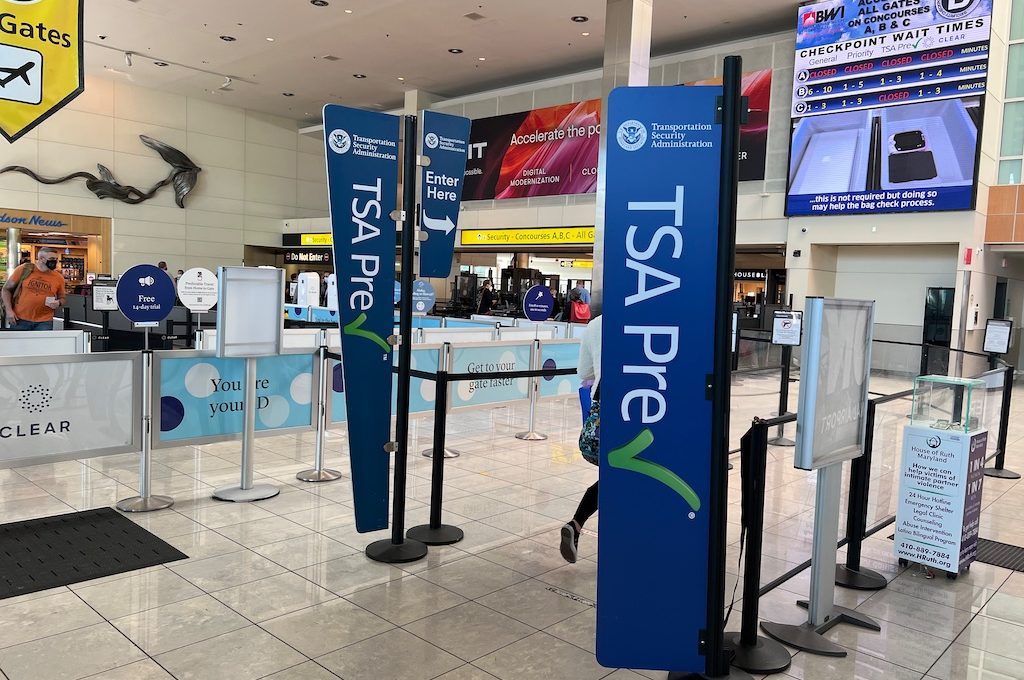
“Sensitive information”
Whether or not you are revealing sensitive information should be a pretty easy thing to determine based on common sense but TSA does provide guidance on the issue.
TSA explicitly mentions that “you may not film or take pictures of equipment monitors that are shielded from public view.”
So for example whenever they run bags through the x-ray scanner and an agent is viewing one of those monitors, you can’t take pictures of that monitor. I assume the same would probably apply to the full body scanner monitors.
This is a very reasonable policy considering that you could be distracting the personnel who need to be monitoring the screens for dangerous explosives.
Plus, I would not want other people “snooping” inside of my baggage and taking photos of the contents I’m traveling with. There could also be medical privacy issues with allowing others to photograph the full body scanners.
Even with that said, some entities like the ACLU question whether or not there is even a legal basis to exclude photos at the stations.
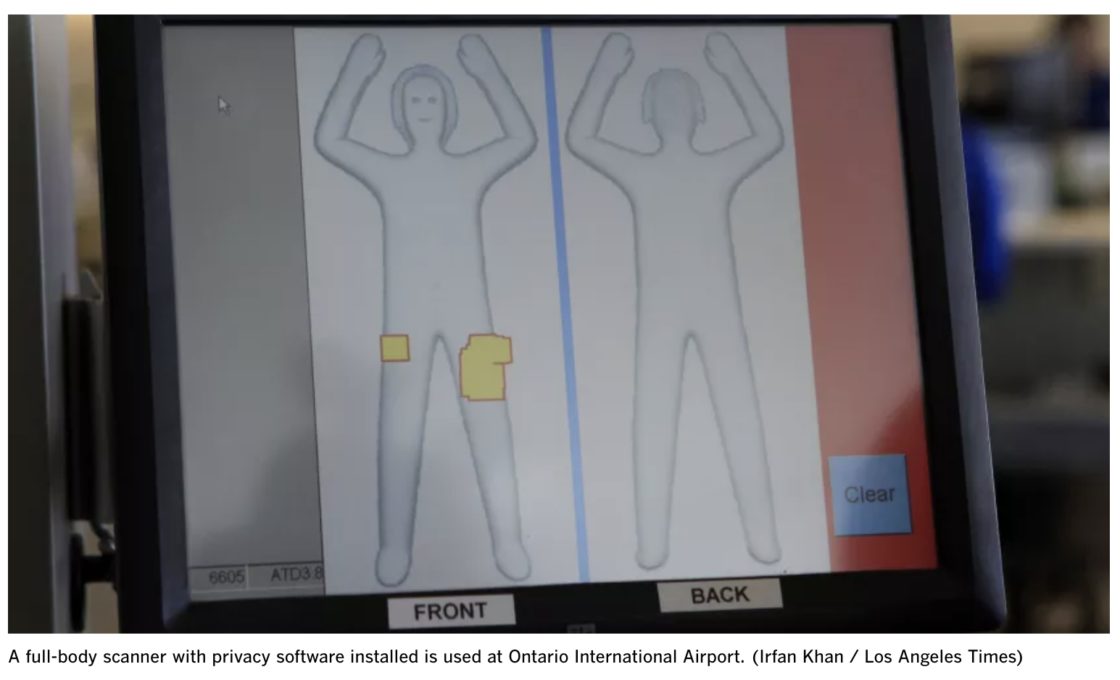
A lack of accountability?
A recent federal court case from the Fourth Circuit shows a real lack of accountability with how this rule on taking video and photographs is enforced.
In that case, a couple was going through security when one of them was subject to a pat down. The spouse attempted to record the pat down (from about 10 feet away) but was told to stop and also to delete the video by a TSA agent and the agent’s supervisor.
They ended up suing on the basis of a First Amendment and Fourth Amendment violation and while the District Court seemed to be ruling in their favor, the appellate court ruled in favor of TSA and essentially granted them immunity.
This means that while you have the right to take photos and record, you probably will not have the support of the courts if those rights are ever infringed upon, which ultimately undermines those rights.
What do airports say about taking photos and videos?
Each airport may have its own policy regarding restrictions on photos and videos and often these may be made in conjunction with the law enforcement divisions that are responsible for overseeing the airport.
For example, the Port Authority which operates John F. Kennedy International, Newark Liberty International, LaGuardia, Stewart and Teterboro airports states the following:
The Port Authority reserves the right to restrict videotaping and photography at its airports. Videotaping and photographing at security checkpoint areas operated by the U.S. Transportation Security Administration is prohibited without the consent of the TSA. Videotaping and photographing in areas controlled by individual airlines, such as check-in or gate areas, is prohibited without the consent of the airline.“
It’s interesting that they point out that consent would be required by the TSA. Based on what is stated on the TSA website, you could argue that consent is already given.
LAX also has a pretty detailed policy on filming and photography.
They state:
Journalists are welcome to conduct reporting, filming or photography within public areas of the airport as long as they do not disrupt passenger flow or otherwise impede airport operations, tenants or passengers
Once again, we see standard language on avoiding the disruption of passengers and airport personnel.
But they go on to mention about filming restrictions that TSA and other entities within the airport such as airlines may impose:
All filming within the gate areas, concessions or other leased spaces is not allowed without the permission of the leaseholders. TSA Public Affairs must approve any filming of the TSA checkpoints in advance. U.S. Customs and Border Protection must approve any filming within customs areas in advance.
So based on the language from these airports, you can gather that filming or possibly taking photographs in areas controlled by individual airlines (leaseholders) like the gate areas may need special consent.
But let’s see what the airlines actually say.
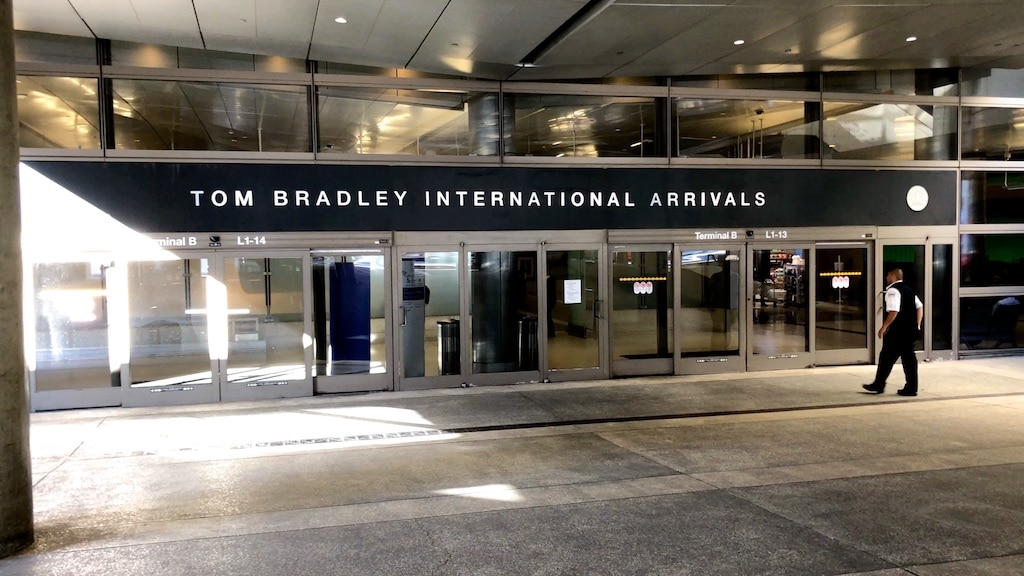
What do airlines say about photos and video?
Unfortunately, airlines do not make it very easy to locate their official policies on photography and videography. Some like JetBlue apparently even keep it internal for security reasons.
However, some airlines like United Airlines have an official page that outlines their (on board) policy. United states:
The use of small cameras or mobile devices for photography and video is permitted on board, provided you limit the purpose of your photography and video to capturing personal events. Any photographing or recording that creates a safety or security risk or that interferes with crew members’ duties is prohibited.
Other airlines probably follow a very similar policy: as long as you’re not getting in the way of anybody or causing trouble, you are probably fine.
It’s also a good practice to not take photos or video of staff members or passengers without their consent unless you have some type of good reason for doing it such as to obtain evidence for a potential claim or criminal matter.
It’s just a matter of not making people uncomfortable so as to prevent a confrontation — not necessarily a legal thing.
Also, whenever you are inside the airport terminal it’s possible that an airline may impose a policy against photographs and video for certain areas.
For example, American Airlines apparently restricts photography at ticket counters, baggage areas, and gates.
Without guidance from the airline it’s hard to know how restrictive (or reasonable) these policies are and how they would hold up in court.
How to get around the airlines’ restrictions
For blog reporting/content purposes, I’ve been taking photos of airport check-in areas, airline cabins, and certain portions of security checkpoints over the past eight years and have barely ever had any issues.
One of the best ways to avoid attracting unwanted attention is to simply look as touristy as possible when taking photographs.
This is really easy to do when you’re traveling with a companion or other people because you simply make it look like you’re taking a bunch of selfies and personal vacation pics while slipping in photos of whatever it is you’re trying to get.
Smile big, wave to the camera, look cheesy, etc. That will get you much further than looking shady with covert camera ops.
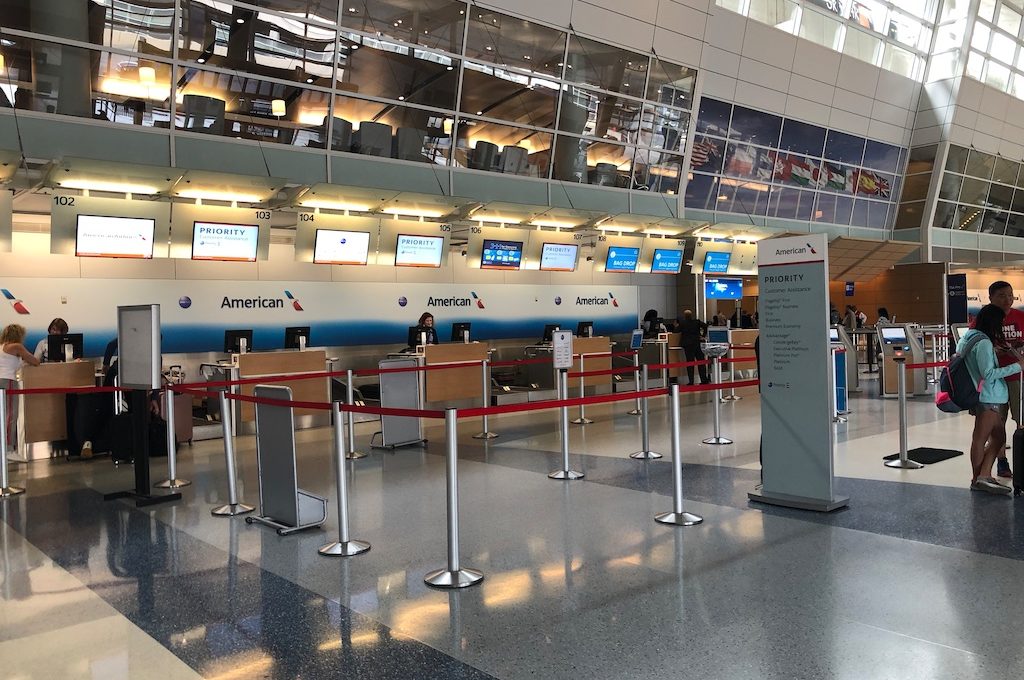
What does the US Constitution and current law say?
In the past, the Supreme Court denied that airports were “public forums.”
“Thus, we think that neither by tradition nor purpose can the terminals be described as satisfying the standards we have previously set out for identifying a public forum.” International Soc. for Krishna Consciousness, Inc. v. Lee, 505 US 672, 683 (1992).
This means that airport terminals don’t offer the strong First Amendment protections that you would find on a sidewalk, street, or park.
Other cases go along with this ruling although some seem to push back at times, so I don’t know the law is 100% settled on if any portions of an airport can qualify as a public forum.
If you look to guidance on public spaces from the ACLU, you’ll see they believe taking photographs and video of things that are plainly visible in public spaces is a constitutional right.
They reiterate that they don’t believe “restrictions on photography in the public areas of publicly operated airports are constitutional.”
My take is that the law is a bit murky when it comes to your First Amendment protections to photograph in airports.
It will probably be okay to do in most areas provided you are not interfering with operations but you may not necessarily have as much legal support as you would think based simply on an airport being a “public space.”
This may not be the hill you want to die on.
Can TSA confiscate your phone for taking photos?
TSA stands for “Transportation Security Administration” and the purpose is to “strengthen the security of the nation’s transportation systems while ensuring the freedom of movement for people and commerce.”
TSA is not looking for drugs like marijuana, trying to track down your arrest warrants, or engage in other types of law-enforcement duties. Moreover, they have not been granted special authority by the US government to engage in certain types of searches and seizures.
Since they lack police power, they cannot demand to see the contents of your photo album or force you to delete photos. [although, see the updated case mentioned above.]
In some cases, in order to get through a checkpoint you could be asked to power on your electronic device to determine if it functions, and your device also could be inspected to ensure that nothing is hidden inside of it.
But if they ask you to log-in to your device or unlock it/view photos or videos, they are overstepping boundaries and you should feel okay with challenging their authority.
In some cases, the local airport police will get involved, usually when a TSA agent calls them over to sort something out.
According to the ACLU, police officers may not confiscate or demand to view your digital photographs or video without a warrant (there may be exceptions in exigent circumstances).
If police get involved, just be respectful and politely request for them to provide you with the authority they are using to deny your ability to film or photograph.
Try to comply as much as possible to avoid escalating the situation but feel free to insist on a warrant if they try to apprehend your phone.
US Customs and Border Protection (CBP)
When it comes to the contents of your phone, things change dramatically when you are dealing with US Customs and Border Protection (CBP) and you’re entering/exiting the United States.
They may be much more strict about cell phone use and photographs and usually they say it is not allowed.
Also, in these areas, the same rules do not apply that require warrants and reasonable suspicion — the contents of your phone, including photographs could be fair game.
That’s because according to the law, you have a reduced expectation of privacy at a border crossing, whether you are coming in or going out.
The case law is still evolving on all of this but CBP has a lot of liberty when it comes to confiscating your phone to review its contents. I would not try to push things with CBP as far as trying to get photographs and video, as they have much more authority than TSA agents.
Also worth mentioning is that when traveling internationally those airports can be a lot stricter with no photography policies.
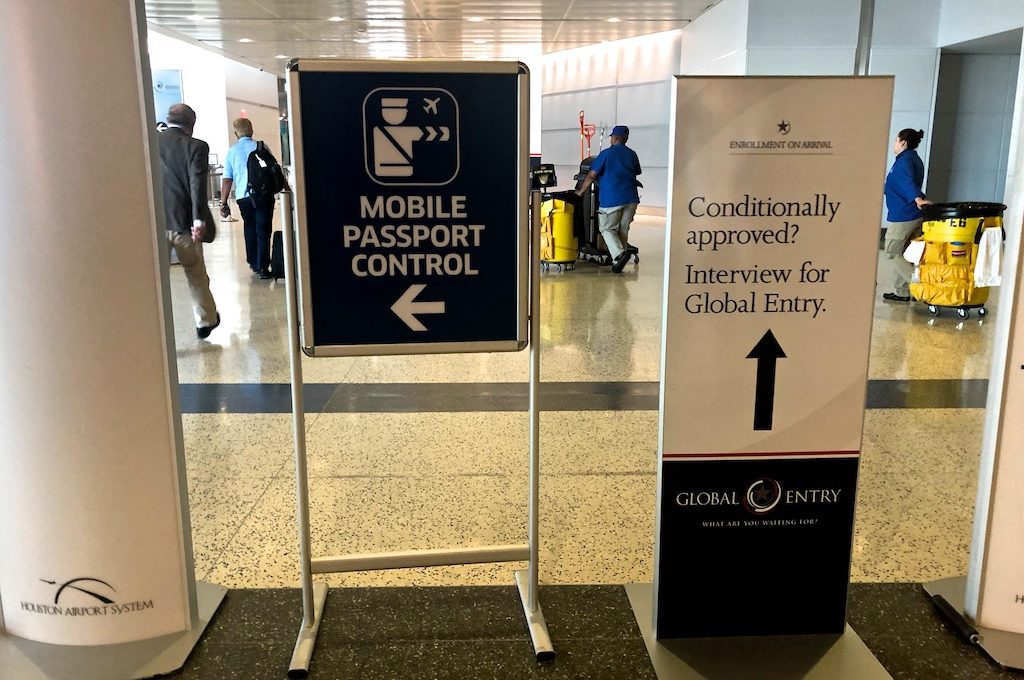
Is it worth the trouble?
The final question to ask yourself is it worth the trouble?
If you go around taking video and photographs throughout the airport you run the risk of encountering issues with TSA, airport staff, airline staff, airport police, other passengers, and potentially CBP or Homeland Security depending on where you are.
There may be some restrictions regarding filming or photographs that you were not aware of. You may also run into individuals who are misinformed on the law and even their own organization’s policies.
Many times, there may be grey areas filled with subjective determinations on things like what constitutes “personal use” or “interference” and that is where the trouble usually begins.
Regardless of who is in the right, just know that if you go around taking lots of photos and videos without much regard this is basically inviting some type of conflict.
You have to ask yourself if this is truly worth it for your goals.
In a worst case scenario, you could be arrested, detained, or placed on some type of government watch list that interferes with your ability to easily get through airports.
Even if you were to take your issue to court and win after a lengthy and costly legal battle, that would still be a huge burden to bear for the sake of some photographs or video.
For some people, fighting such a fight is worth it but I would venture to guess that for most of us, that type of legal fight is not something we would be interested in going through.
My advice would be to not let your emotions get the best of you if someone ever tries to clamp down on your ability to take photos or videos.
My go-to move is to just comply and put my phone away and then if I really need the photos try to get some a little bit later when that individual is out of the picture (literally and figuratively). Otherwise, I’ll just drop it.
Pick your battles wisely.
Final word
Taking photographs and video in an airport is often not a problem so long as you do it in areas where security is not an issue, you are not interfering with airport operations, and you are not taking pictures of people without their consent.
Although airports are public spaces, it’s not clear what level of free speech protections you have because airports are not “public forums” in the legal sense.
So my advice would be to stick with getting personal travel photos that come off as touristy captures and try to resist encroaching on airport personnel.
Because even if you do have the right to film or take certain photos, it’s often not worth the hassle that will follow. And in some cases, your legal rights may not be as strong as you think they are.
Daniel Gillaspia is the Founder of UponArriving.com and the credit card app, WalletFlo. He is a former attorney turned travel expert covering destinations along with TSA, airline, and hotel policies. Since 2014, his content has been featured in publications such as National Geographic, Smithsonian Magazine, and CNBC. Read my bio.

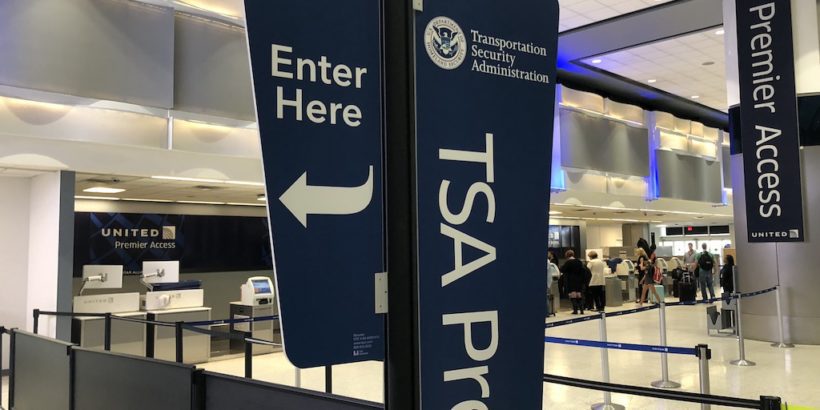
The TSA is a criminal organizational that rapes the traveling customers and US taxpayers with their criminal activities 24/7 with impunity and complete immunity. FOIA request are seldom answered and when they are, they’re either complete fabrications or misdirections. Even the TSA OIG is apathetic to to this plague.
TSA has absolutely no official, authorized, standardized, agency wide training of any kind and they blindly follow orders, lawful or not. It’s any agency full of cowards who are ready to Barney Fife a customer for looking crosseyed at them because they no they’re protected. They’re arrogant, pretentious, whiny, condescending punks who think they wield real authority.
During my last trip, I’d asked five TSA officers at an AA DFW airport checkpoint what Title 5 was. Not one person had even heard of it.They’re part time rent a cops and they act this way because the the politicians cheaped out on hiring qualified security personnel and to make up it, they swarm every checkpoint with 18 year old kids making slightly better than minimum wage with no benefits. Strength in numbers.
They have absolutely no idea how to assist the disabled. Every time we fly, these idiots haven’t a clue how to screen my blind wife. I’ve been engaged in a mostly one sided “dialogue” with TSA for some time now and I know of which I speak.
Public Law 107-71, the knee jerk law that was approved post 9-11 obligates TSA employees to be courteous to their customers. I’ve an FOIA request currently awaiting response how often the law has been revised since 2001. I’ve another FOIA request requesting data of how many times the law has been amended. Almost a week now. Crickets.
I’m going to take a short poll on my next trip and see if the children are aware of this. If you experience unprofessional, discourteous, Third Reich Nazi tactics or civil violations by these one-celled organisms, call them out. Right there. DO NOT WAIT. Every terminal has Title 5 full time Federal Employee TSA supervisor and demand to see them post haste. File a formal complaint via TSA.gov. Send TRANSEC Peter Paul Buttigieg – Mob Boss – a strongly worded letter.
I promise another vigorous debate with the Neanderthals at the airport is forthcoming.
If you don’t say anything, you’re part of the problem.
Willam Kiefer
We video tape tsa during our screenig and going through check points. First we video tape the individual who looks at passport and boarding pass. Second we video tape the check point screeing, going trough scan mashine ( me and my stuff). We are never in the face and we are respectufl. It will help me to recover damages when they are not respectulf and try to do something. All of this is LIVE streamed, no exception. So no, they will not be able to come up with something else.
America was conceived in liberty but now it’s a pile of fucking garbage.
They want everyone eating at McDonald’s and shopping at Walmart. They want you to embrace female promiscuity and a white minority in every country on Earth. Work hard and play by the rules means be a wage slave and a cuck.
Baby Boomer degenerates, women voting, and lowered testosterone levels from plastic in the food did this.
Gen z morons will make damned sure we lose the entire Bill of Rights including speech and arms, the motherfucking brain dead jackasses.